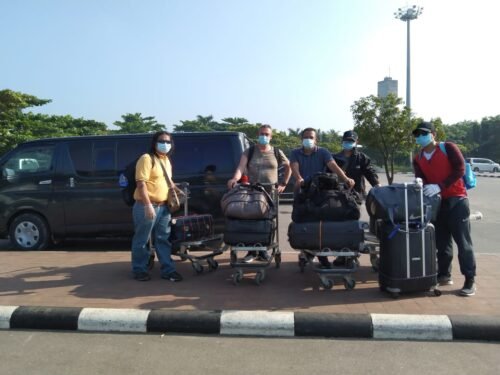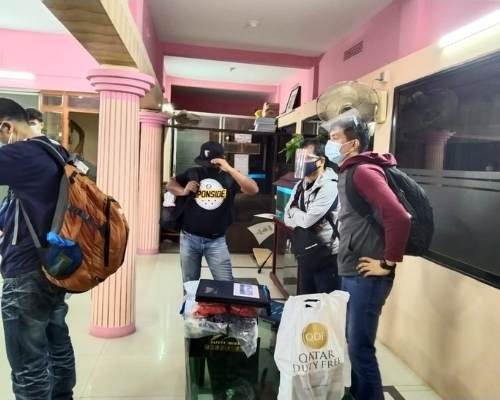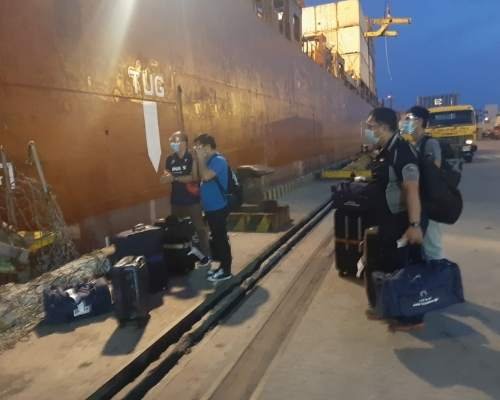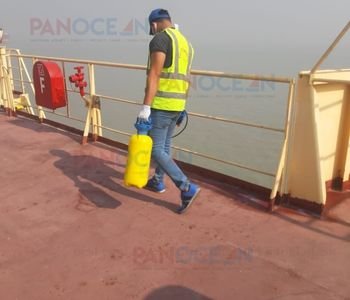Bangladesh’s economy is starting to suffer from coronavirus impact – just two ships arrived at Chittagong from China in February.
Ministry of Shipping, Bangladesh issued a circular recently to prevent the spread of the COVID-19 virus, all arriving vessels are required to submit the following documents to the Port Health Chattogram/Mongla/ Payra before arrival at Port of Chattogram/Mongla/ Payra:
Vessels arriving from ports of infected countries within 14 days of departure from the infected port, or having seafarers embarked on the vessel who have been in infected regions within 14 days of arrival at any Bangladeshi port shall comply with the following additional measures:

1. Health authorities shall grant pratique prior berthing as per necessary health protocols.
2. The mooring ropes and pilot ladders of such vessels shall be sanitized.
3. The pilot shall be provided full-body protection suit.
4. Mooring boat and mooring gang to be provided with adequate PPE, if applicable.
5. Gangway to be kept in raised condition at all times.
6. No person to be permitted on board without specific permission from port authorities.
7. All personnel boarding the vessel for cargo operations shall wear full body protection suit. Also the used PPE shall be disposed off as per the appropriate protocols.
8. Vessel staff assisting in cargo operations to also wear full-body protection suit and maintain safe distance of at least 6 feet.
9. Vessel to sanitize and disinfect after the completion of cargo operations.

Cleaning guidelines for areas exposed to the confirmed case(s) of COVID-19 in nonhealthcare premises
a. Where possible, seal off areas where the confirmed case has visited, before carrying out cleaning and disinfection of the contaminated environmental surfaces. This is to prevent unsuspecting persons from being exposed to those surfaces.
b. When cleaning areas where a confirmed case has been, cleaning crews should be attired in suitable PPE (see Section B above). Gloves should be removed and discarded if they become soiled or damaged, and a new pair worn. All other disposable PPE should be removed and discarded, after cleaning activities are completed. Goggles, if used, should be disinfected after each use, according to manufacturer’s instructions. Hands should be washed with soap and water immediately after the PPE is removed.
c. Keep cleaning equipment to a minimum.
d. Keep windows open for ventilation, where workers are using disinfectants.
e. Mop floor with disinfectant or the prepared bleach solution. f. Wipe all frequently touched areas (e.g. lift buttons, hand rails, doorknobs, arm rests, seat backs, tables, air/ light controls, keyboards, switches, etc.) and toilet surfaces with chemical disinfectants (use according to manufacturer’s instructions) and allow to air dry. Bleach solution (dilute 1 part bleach in 49 parts water, 1000 ppm or according to manufacturer’s instructions) can be used. Alcohol (e.g. isopropyl 70% or ethyl alcohol 70%) can be used for surfaces, where the use of bleach is not suitable.
g. Clean toilets, including the toilet bowl and accessible surfaces in the toilet with disinfectant or bleach solution.
h. Wipe down all accessible surfaces of walls as well as blinds with disinfectant or bleach solution.
i. Remove curtains/ fabrics/ quilts for washing, preferably using the hot water cycle. For hot-water laundry cycles, wash with detergent or disinfectant in water at 70ºC for at least 25 minutes. If low temperature (i.e. less than 70ºC) laundry cycles are used, choose a chemical that is suitable for low-temperature washing when used at the proper concentration.
j. Arrange for a cleaning contractor to properly disinfect the mattresses, pillows, cushions or carpets that have been used by the person who has been confirmed to have the COVID-19.
k. Repeat mopping the floor with the prepared disinfectant or bleach solution.
l. Discard cleaning equipment made of cloths and absorbent materials, e.g. mop head and wiping cloths, into biohazard bags after cleaning and disinfecting each area. Wear a new pair of gloves and fasten the double-bagged biohazard bag with a cable tie.
m. Disinfect non-porous cleaning equipment used in one room, before using for other rooms. If possible, keep the disinfecting equipment separated from other routine equipment.
n. Disinfect buckets by soaking in disinfectant or bleach solution, or rinse in hot water before filling.
o. Discard equipment made of cloths/ absorbent materials (e.g. mop head and wiping cloths) after cleaning each area, to prevent cross-contamination.
p. A disinfectant or bleach solution should be applied to surfaces using a damp cloth. They should not be applied to surfaces using a spray pack, as coverage is uncertain, and spraying may promote the production of aerosols. The creation of aerosols caused by splashing liquid during cleaning should be avoided. A steady sweeping motion should be used when cleaning either floors or horizontal surfaces, to prevent the creation of aerosols or splashing. Cleaning methods that might aerosolize infectious material, such as the use of compressed air, must not be used.
q. Leave the disinfected area and avoid using the area the next day.
r. Biohazard bags should be properly disposed of, upon completion of the disinfection work.
Vessels coming directly from China will need to wait offshore for at least an extra week before being allowed to berth at Bangladesh’s Port of Chittagong due to precautions over the coronavirus. It typically takes a ship seven to eight days to reach Chittagong after departing China. But Bangladeshi authorities want vessels to spend at least two weeks on the water after leaving China so there’s ample time to determine whether anyone onboard is infected with the coronavirus.









